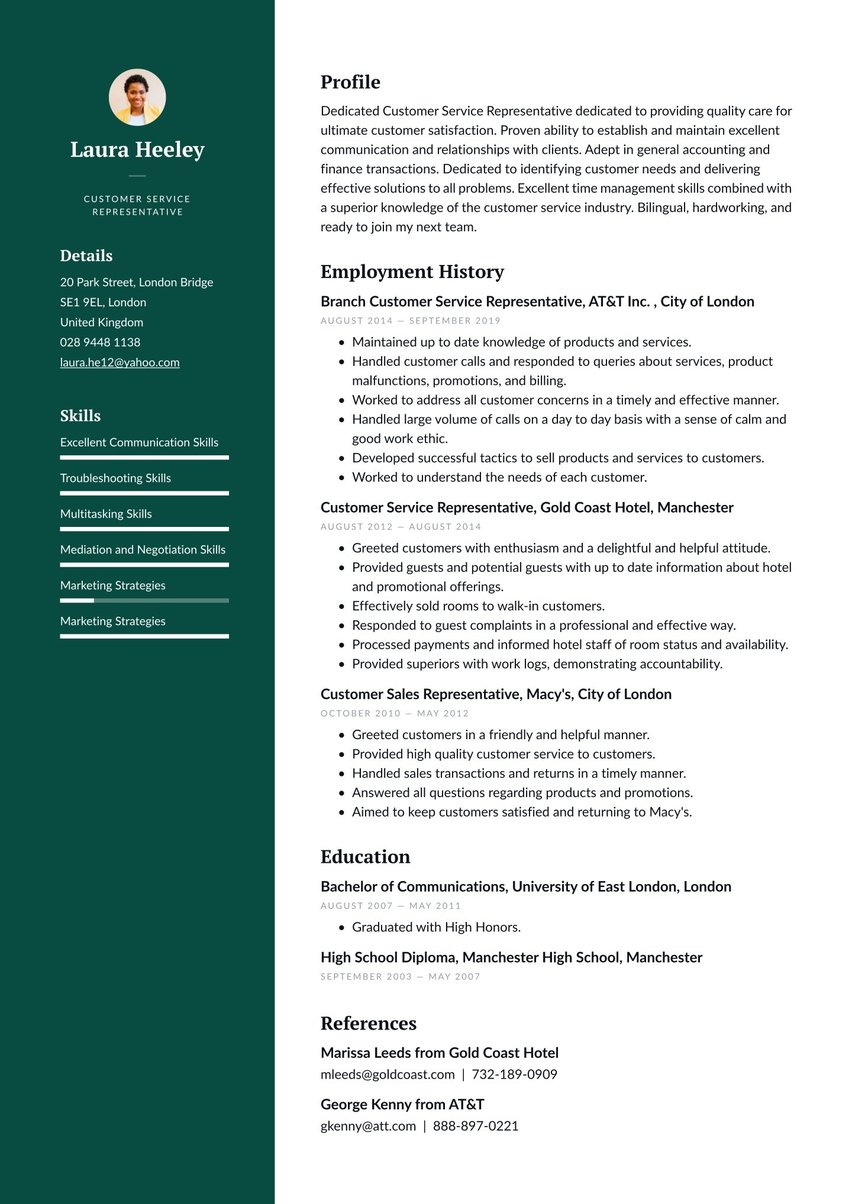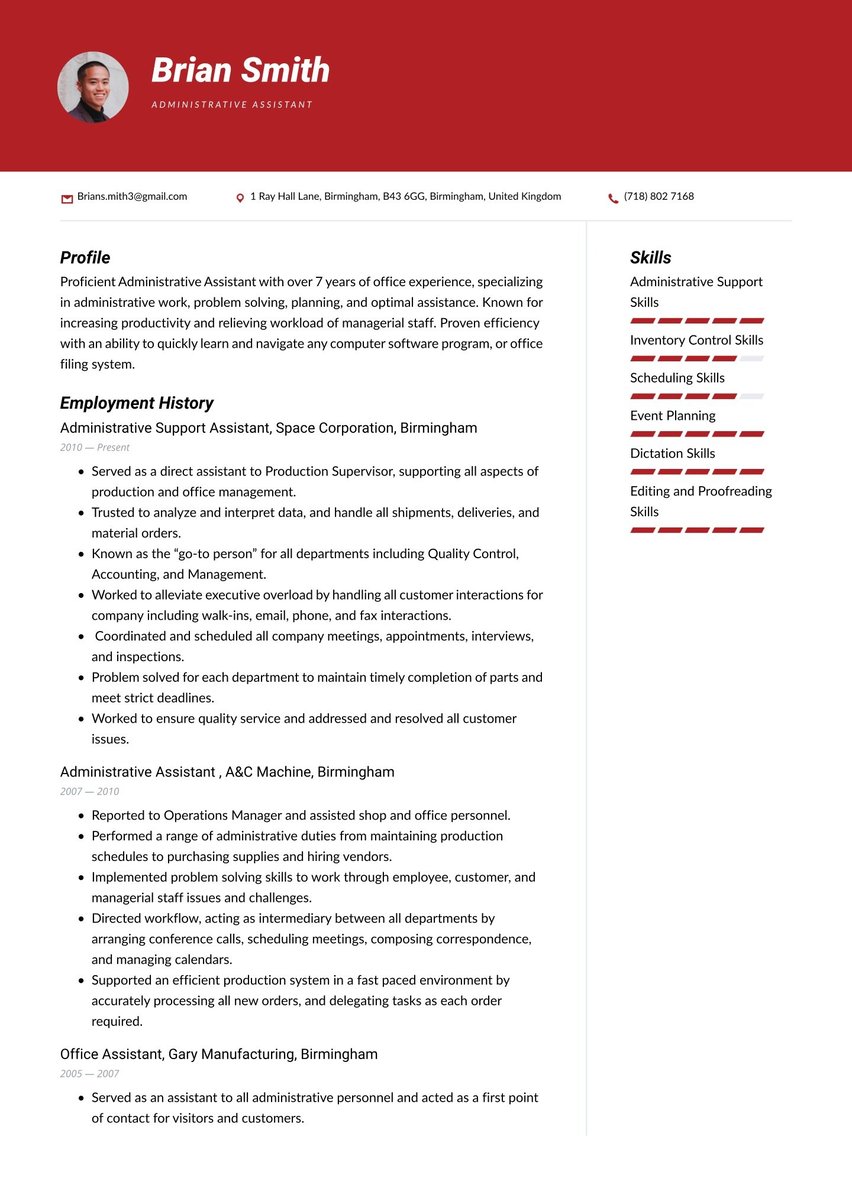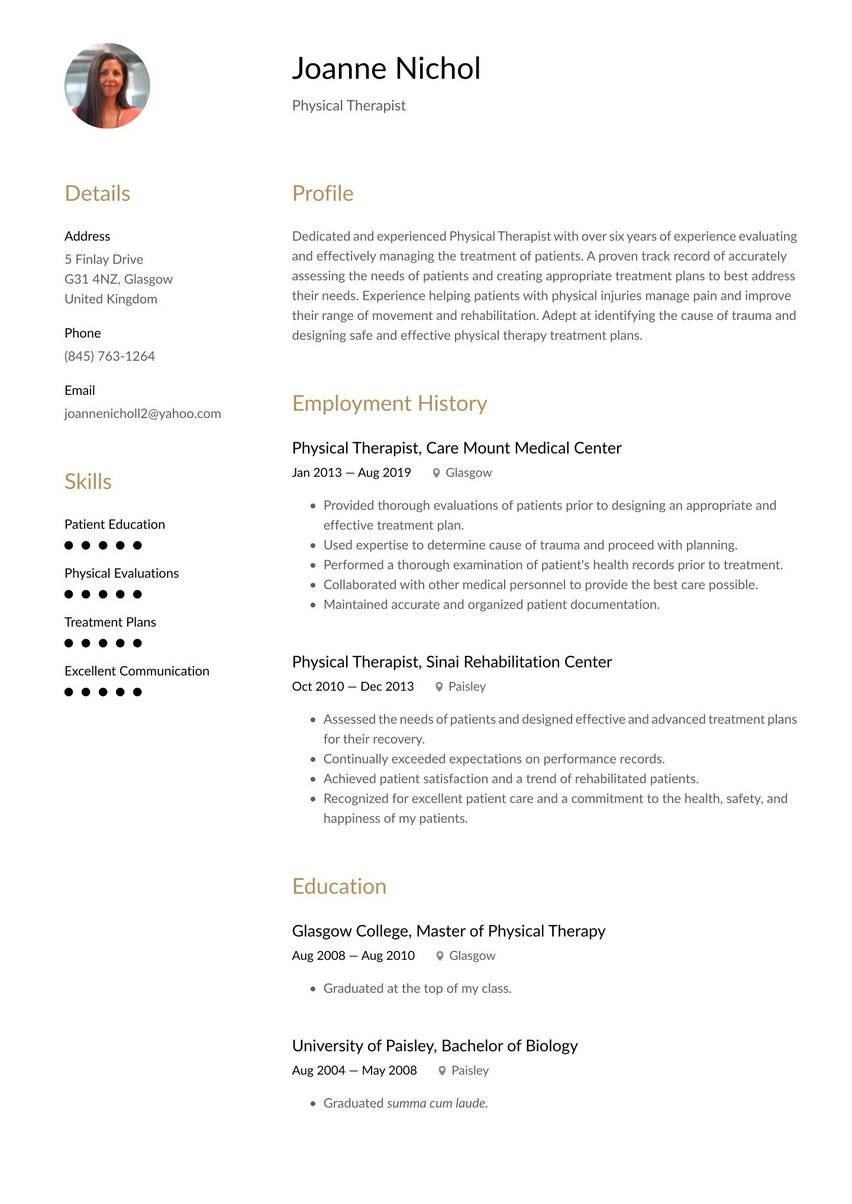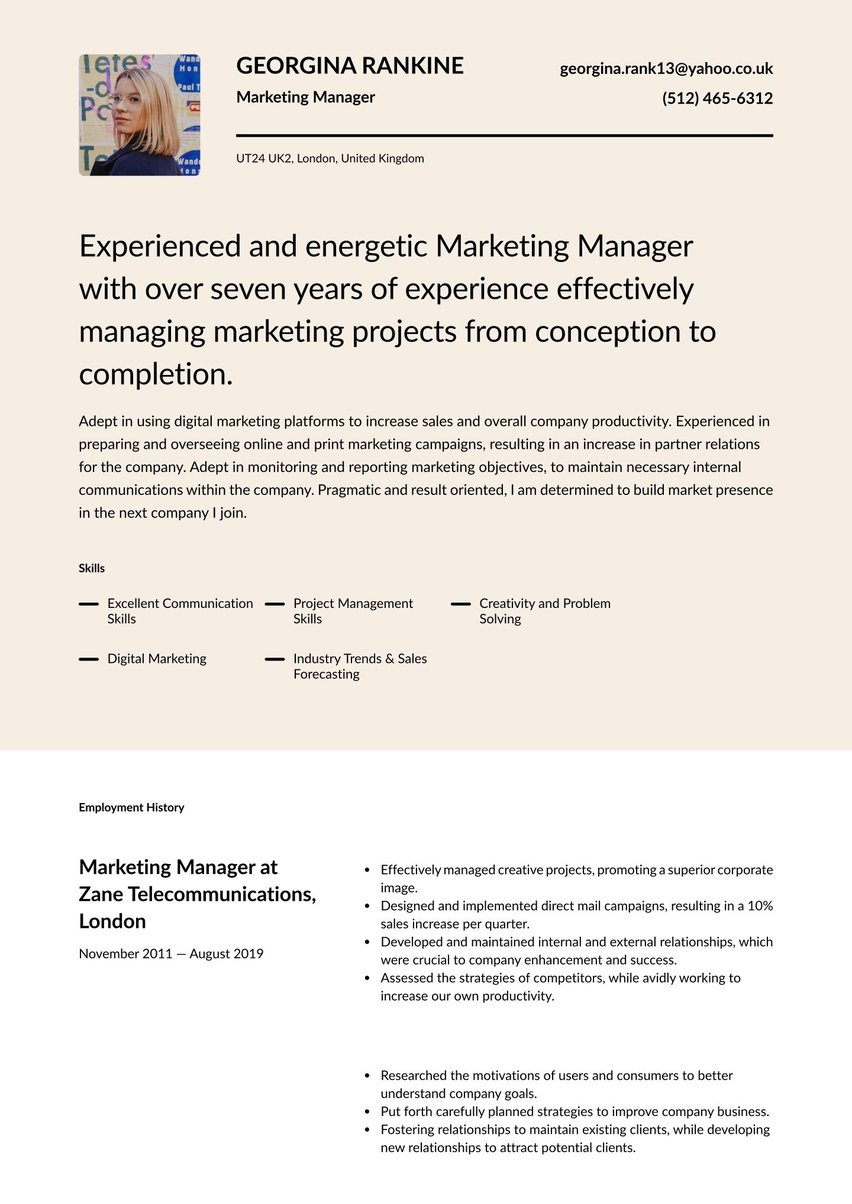Highly skilled and safety-conscious train driver with 15 years of experience operating various types of trains, including freight trains, across the UK rail network. Committed to providing excellent customer service, ensuring passenger comfort, and maintaining strict adherence to safety regulations and schedules.
02/2012 - present, Train Driver, ScotRail, Edinburgh
- Operated passenger trains, ensuring safe and timely journeys
- Conducted thorough pre-service checks on trains, reporting any faults or issues
- Adhered to railway rules, regulations, and signalling systems to maintain safe operations
- Provided clear and concise announcements to keep passengers informed during journeys
- Responded effectively to emergency situations and service disruptions
01/2010 - 01/2012, Trainee Train Driver, ScotRail, Edinburgh
- Completed comprehensive training program, gaining knowledge of train operations, safety procedures, and route familiarization
- Shadowed experienced train drivers to learn best practices and develop practical skills
- Assisted with shunting operations and coupling/uncoupling of trains
- Participated in regular assessments and evaluations to track progress and competency
- 02/2011, Train Driver's License, , Edinburg
- 02/2010, GCSE, St Margaret's Academy, Livingston
- Extensive knowledge of UK railway rules
- regulations
- and signalling systems
- Proficient in operating passenger trains and related equipment
- Excellent concentration
- situational awareness
- and decision-making skills
- Strong communication and customer service skills
- Ability to work effectively under pressure and maintain a calm demeanor
Your train driver CV is what keeps the wheels turning on your job search. A well-written CV makes it clear to the hiring manager why you’re the train driver for this job and gets you one step closer to landing that interview.
So how can you write a train driver CV that grabs a hiring manager’s attention in a few short seconds and keeps them engaged? With some compelling writing that leans on your key skills as a train driver.
As a train driver, you understand the importance of a balance between excellent technical skills and clear communication. Those are exactly the skills you need to write a top CV, too. So stick with us. Through the rest of this writing guide, we will show you how to get your CV writing on the right track.
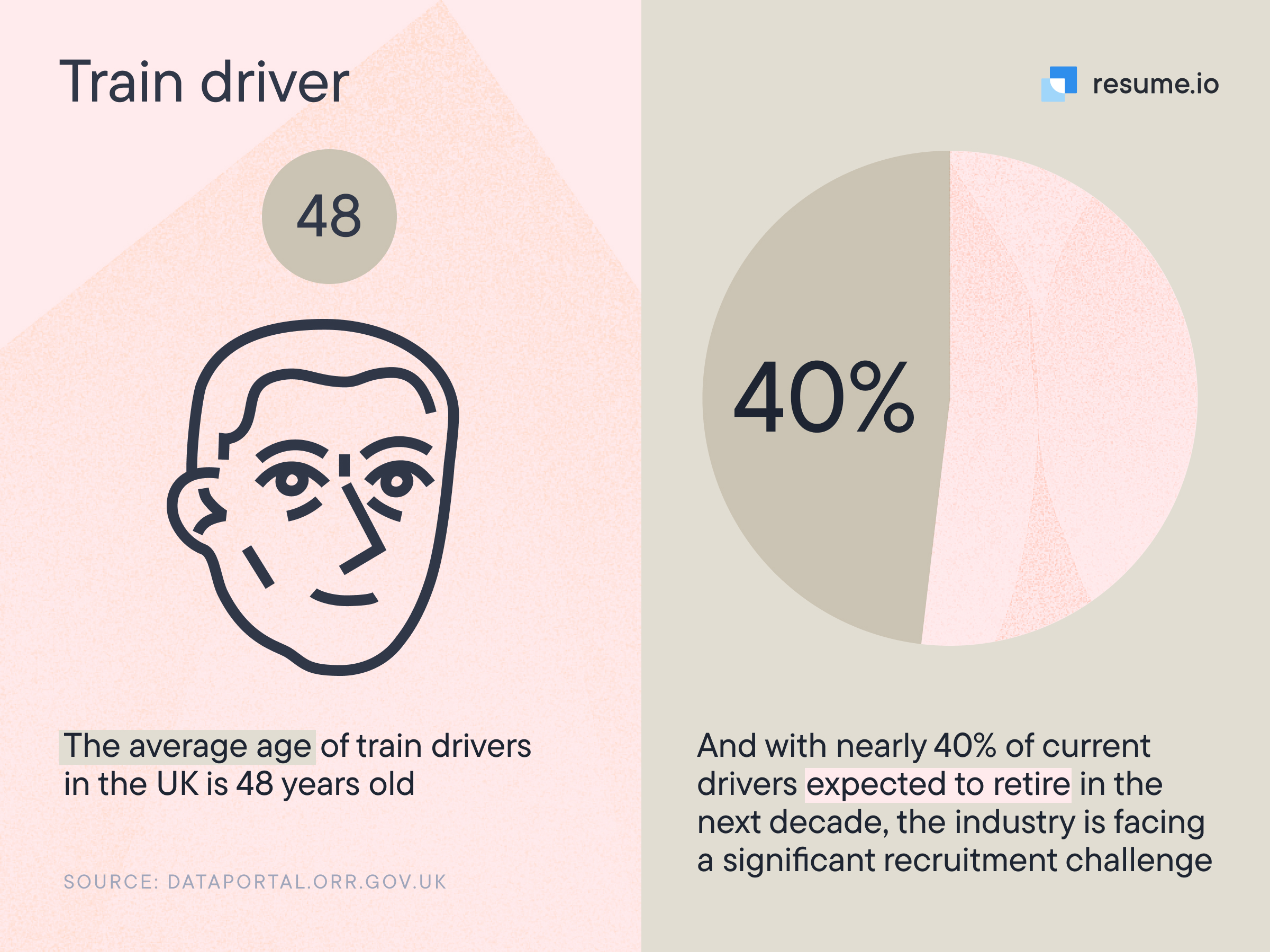
CV guide for a train driver CV
You can hop on the track to success with Resume.io. Our guides and CV examples cover over 150 professions. Plus, our CV builder makes creating your CV speedy and simple.
This CV guide and corresponding train driver CV example will cover the following:
- How to write a train driver CV
- Choosing the right CV format for train driving
- How to add your contact information
- Using summaries
- Adding your train driver experience
- Listing education and relevant experience
- Picking the right CV design/layout
- What the train driving market looks like, and what salary you can expect
How to write a train driver CV
The first step in writing your train driver CV is understanding what sections to include. Your CV should contain the following elements:
- The CV header
- The CV summary (aka profile or personal statement)
- The employment history section
- The CV skills section
- The education section
Your job application is the prep to get the train ready to depart. Sure, you need an enthusiastic hiring manager to give you the green light before you can get into the role. But there will be no getting out of the station if you don’t have a strong job application, which must include a top train driver CV example.
Consider these top tips to write a train driver CV that will get you where you need to go:
- Highlight accomplishments in your previous roles as a train driver. This demonstrates better communication skills than listing responsibilities or tasks. It engages the hiring manager’s imagination and highlights the results that you could drive in this role.
- Tailor your CV depending on the job you’re applying for. You can figure out exactly what the hiring manager is looking for through your research of the company and careful reading of the job description.
- Target the ATS by using the most relevant keywords from the job description. Scatter them in strategic spots throughout your CV.
Optimise for the ATS
ATS stands for Applicant Tracking Systems. This software ranks all the applications for the job according to the presence of certain keywords. How can you figure out what these keywords are and make sure they’re present in your CV? By reading the job description carefully and matching the language in your CV accordingly.
If you don’t your CV will be unlikely to make it in front of a pair of human eyes. Only the highest-ranking CVs pass through to be reviewed by human hiring staff.
For example, a train driver job posting might list keywords such as:
- “Train driver”
- “5+ years of train driving experience”
- “Clean safety of the line record”
- “DBS Enhanced Check”
- “Strong time management skills”
You can read more about beating the ATS in our dedicated guide on writing a CV for the ATS scanners.
Choosing the right CV format for train driving
Your train driver's CV should be well-presented and organised, just like the qualities of a great train driver.
The best CV format for most train driver CV examples is the reverse chronological. This format prioritises your previous job experience, listed in reverse chronological order. You can see below what this format looks like in action with our adaptable train driver CV sample content.
If you don’t have much work experience yet, or your experience is based on specialist skills, then consider using a functional CV format instead.
When choosing the best CV template, think about what your prospective employer would like to see. You can adapt any of our CV sample content below in a variety of field-tested CV templates via our CV builder. We recommend using a simple layout.
Include your contact information
Just like your passengers want to know the basic practical information on how to get to their destination when they look at the train schedule, your CV header should give the hiring manager some key information on who you are and how to get in touch with you.
The most important box to tick is making your contact details clearly accessible in case the hiring manager wants to contact you. Make sure you include the following information:
- Full name & title. List your first and last name. Match your job title to the name of the role you’re applying for.
- Professional email address. Use a professional email address like firstname.lastname@gmail.com.
- Phone number. List a number where you can be easily contacted. Remember to ensure your voicemail message is appropriate for the ears of the hiring manager, too.
- Location. Don’t list your street address or postcode. This is now considered outdated and unsafe. Note 'Willing to Relocate' if applicable.
- LinkedIn. If your LinkedIn profile is active, relevant, and shows your professional network, it could be a good idea to include it.
Don’t include:
- Date of birth: Listing this is no longer considered necessary, so don’t open yourself to potential age discrimination.
- Personal details: Your marital status, your national insurance number, your passport number, or other personal data should not be on a document like your CV which you hope will be circulated among professionals you don’t know.
William Shaw
Train Driver
0700033111
lydia.shaw@email.com
Billy Shaw
Top Train Driver
0744888222
billz444@email.com
Make use of a summary
Your job may centre on getting your passengers from A to B. But the hiring manager will need a little coaxing to engage with what you’re offering. So, butter them up a bit by writing a compelling CV summary that makes them want to find out more about you.
Your CV summary is what will hook the hiring manager’s attention. In two to three sentences, find a way to summarise why you are the right candidate for this particular position. You should include the most important reasons why your experience matches the job description. But, you should also deliver it in a way that’s engaging.
So consider using some dynamic action verbs. This will help you to keep your writing concise and descriptive.
It’s easy to be tempted to make your CV summary a repetition of impressive points from other places on your CV. That’s one strategy. But if you want to make it to your destination - that is, being hired in a new role - we recommend making the most of the limited space on your CV. Prioritise the most important points in your CV summary, and aim to avoid repetition throughout the rest of your train driver CV sections.
However, your CV summary sets the tone for the rest of your CV. So make sure you’re prepared to write a cohesive CV where each section tells the same story and builds a clear picture of the type of professional you are.
Need inspiration for your summary? Check out our related CVs:
You can find adaptable train driver CV examples for your summary below:
Enthusiastic and organised Train Driver with level 3 train driver apprenticeship and experience keeping multiple regional and cross-country train routes on time. Clean safety on the line record and dedicated to maintaining a safe rail service experience for passengers.
Highly driver Train Driver with 5+ years experience in regional services. Proven track record in maintaining a safe working environment and making decisions to keep busy services running smoothly. Excellent communication skills and ability to work under pressure.
Experienced train driver with 10+ experience on regional and cross-country routes. Knowledgeable in health and safety regulations and expertise in bringing together multiple stakeholders to ensure a safe and timely service. Clean safety on the line record and valid DBS Enhance Check.
Outline your train driver work experience: on the right track
Start your work experience section with your most recent train driver job experience. Work your way back to your first job, or the most relevant job in the last 10-15 years. Include only work experience that is relevant to the role in this section.
For each job you choose to include on your CV, create a subheading with the following information:
- Job title
- Name of employer
- Location of job
- Dates of employment
Under each subheading, include several bullet points that highlight your achievements that would be useful for the hiring manager to know about. We recommend avoiding a list of your tasks. That’s because accomplishments better show off your skills, your relevant experience, and the results you generated in a short space.
For instance, simply listing tasks could mean the hiring manager needs to use their imagination to understand the outcome of your contribution:
- “Responsible for driving daily London to Newcastle train route.”
- “Updated customers on route and advice for their journey.”
- “Kept trains on schedule.”
Instead, reword them into something that engages the hiring manager’s attention and explains why you would be a great addition to their team:
- “Oversaw adherence to health & safety rules in train cab, leading to zero health & safety infringements during my time leading the London to Newcastle route.”
- “Advised customers on alternate routes, resulting in excellent customer satisfaction ratings.”
- “Led team in making decisions to keep to schedule, leading to safe and on-time arrival for 90% of journeys.”
Take a look at the train driver employment history CV sample below.
Train Driver at ScotRail, Edinburgh
2012 - Present
- Operated passenger trains, ensuring safe and timely journeys
- Conducted thorough pre-service checks on trains, reporting any faults or issues
- Adhered to railway rules, regulations, and signalling systems to maintain safe operations
- Provided clear and concise announcements to keep passengers informed during journeys
- Responded effectively to emergency situations and service disruptions
Trainee Train Driver at ScotRail, Edinburgh
2010 - 2012
- Completed comprehensive training program, gaining knowledge of train operations, safety procedures, and route familiarization
- Shadowed experienced train drivers to learn best practices and develop practical skills
- Assisted with shunting operations and coupling/uncoupling of trains
- Participated in regular assessments and evaluations to track progress and competency
How to write a train driver CV with no experience
You may be writing your train driver CV for the first time. However, the training necessary before you can operate a train alone means that you’ll have some good content for a CV for a trainee train driver.
Focus on the skills that you gained during your time in training. One way to highlight this is to list your work experience or apprenticeship title in your previous employment section. Just be careful not to overstate your contribution or outright lie on your CV. You may already have some great accomplishments during your time in the apprenticeship role that will highlight your expertise.
Otherwise, simply lean into your training with a functional CV format. We recommend leaning into your transferable skills and other strengths demonstrated in past work experience or extracurricular activities at school, too. This way you’re sure to have a strong document even if you’re preparing a trainee train driver CV example.
Include the relevant key skills that make you a great train driver
Your skills list should combine a healthy balance of hard skills and soft skills. After all, you need a mix of both to be a great train driver. Your technical skills may be important to get everyone safely from A to B. However, the way you work with your team members and interact with the public is fundamental to becoming a successful train driver.
Skills like problem-solving, customer service, and excellent communication are all soft skills that are needed to become an excellent train driver.
Here’s what the skills box looks like in our train driver CV template.
- Extensive knowledge of UK railway rules, regulations, and signalling systems
- Proficient in operating passenger trains and related equipment
- Excellent concentration, situational awareness, and decision-making skills
- Strong communication and customer service skills
- Ability to work effectively under pressure and maintain a calm demeanor
Consider thinking outside of the skills box, too. You can speak to your train driver skills in other sections of your CV, such as your summary or the bullet points of your previous work experience.
For example, you can find examples from your past experience that highlight your:
- Organisational skills. Your ability to keep on top of your tasks and help others to keep on top of theirs is essential to keeping a train route running smoothly.
- Leadership skills. Whether or not you directly oversee other staff members, your expertise may call on you to make decisions and call on other team members to help you.
- Time management. Being punctual is a coveted key strength if you’re pursuing a career as a train driver.
Look to the job description as a guide for what key skills you shouldn’t miss out.
Detail your education & relevant train driving certifications
The education section is where you can list your formal education. However, depending on your role and training, you may want to list other certifications and training here, too. For instance, you can list any qualifications from secondary school or college such as GCSEs, BTECs, or A levels.
For each qualification, list the following information:
- Qualification name
- The institution where you studied
- Location
- Dates of attendance
You should include the same information for other types of qualifications. Consider some of the following types of education to list on your train driver CV:
- Training and certifications. These could range from official training certifications to webinars that enhance your skills as a train driver. For instance, an EAL rail qualification.
- Apprenticeships. If you have had industry training or experience on the job while you work towards a qualification, an employer will want to hear about it. For instance, you could list your Level 3 Train Driver apprenticeship here.
- Professional development. Any memberships that show a commitment to continued learning - such as a membership to the Chartered Institute of Railway Operators - could show your proactive attitude.
Remember, if you currently have more training than work experience, you may want to consider opting for a functional CV format. You could even split your education section into two sections: one for your formal education, and another for short training courses.
Take a look at the education section from a sample CV of a train driver below.
Train Driver's License, Edinburg
2011
GCSE, St Margaret's Academy, Livingston
2010
Pick the right CV layout and design for a train driver CV
Your CV’s design should be representative of the message you’re sharing through your written content. In the case of a CV for a train driver job, we recommend a professional layout that shows great organisation and trustworthiness.
While of course, you want to grab the hiring manager’s attention, this should be for the right reasons. Stay away from gimmicky CV layouts. Not only will they likely be a turn-off for the hiring manager, but they’re unlikely to make it past the ATS.
Aim for something that’s eye-catching because of its clear layout. Find a clear way to visually mark your headers, subheaders, and CV body. Usually, this is done through the sizing and style of fonts. However, make sure you leave sufficient space between sections and that your text isn’t too small to read.
When it comes to the size of your text, we recommend something no smaller than a 12-point typeface. When it comes to typefaces, two fonts on your CV tend to be the suggested maximum.
A CV template can help you to achieve all of the above if you don’t fancy doing it yourself.
Train driver text-only CV example
Profile
Highly skilled and safety-conscious train driver with 15 years of experience operating various types of trains, including freight trains, across the UK rail network. Committed to providing excellent customer service, ensuring passenger comfort, and maintaining strict adherence to safety regulations and schedules.
Employment history
Train Driver at ScotRail, Edinburgh
2012 - Present
- Operated passenger trains, ensuring safe and timely journeys
- Conducted thorough pre-service checks on trains, reporting any faults or issues
- Adhered to railway rules, regulations, and signalling systems to maintain safe operations
- Provided clear and concise announcements to keep passengers informed during journeys
- Responded effectively to emergency situations and service disruptions
Trainee Train Driver at ScotRail, Edinburgh
2010 - 2012
- Completed comprehensive training program, gaining knowledge of train operations, safety procedures, and route familiarization
- Shadowed experienced train drivers to learn best practices and develop practical skills
- Assisted with shunting operations and coupling/uncoupling of trains
- Participated in regular assessments and evaluations to track progress and competency
Skills
- Extensive knowledge of UK railway rules, regulations, and signalling systems
- Proficient in operating passenger trains and related equipment
- Excellent concentration, situational awareness, and decision-making skills
- Strong communication and customer service skills
- Ability to work effectively under pressure and maintain a calm demeanor
Education
Train Driver's License, Edinburg
2011
GCSE, St Margaret's Academy, Livingston
2010
Train driver job market and outlook
The travel industry is returning to pre-pandemic levels and there is a growing push for individuals and businesses to become more environmentally sustainable. This means it’s an exciting time for the rail industry to be part of this change. If you want to be part of it, it could be the right time to jump on board a career track as a train driver.
Industry outlet Railway Technology reports that 90% of the UK’s SMEs expect to do more business travel in 2024. Plus, over half of the UK’s business travellers reported preferring working for an employer that prioritises a low-carbon footprint.
What type of salary you can expect as a train driver
According to the National Career Service, train drivers can expect an annual salary between £24,000 and £65,000. Where you fall in this bracket will likely depend on location and experience. You can expect to work 35-40 hours per week on shifts, including weekends and evenings.
Key takeaways for building a train driver CV
A career as a train driver could be a fulfilling way to serve the public and be part of a shift to more low-carbon travel. The key to landing a great role is telling a cohesive story on your CV about why you possess the right skills and experience for the job. If it’s your first role, lean into transferable skills and examples of results you’ve facilitated during your training. All you have to do is grab the interest of the hiring manager enough to get invited to interview.
Using our online CV builder could be a great way to save time, make the right impression with your train driver CV, and get one step closer to landing that interview.






